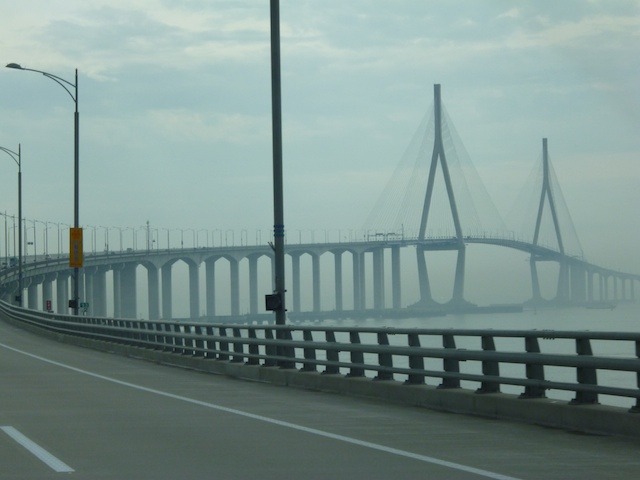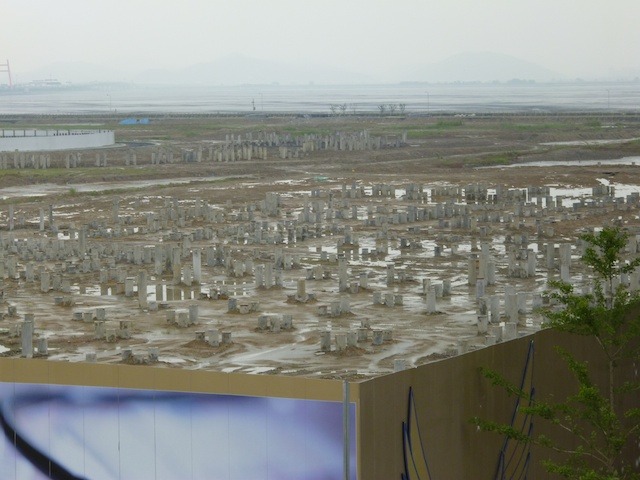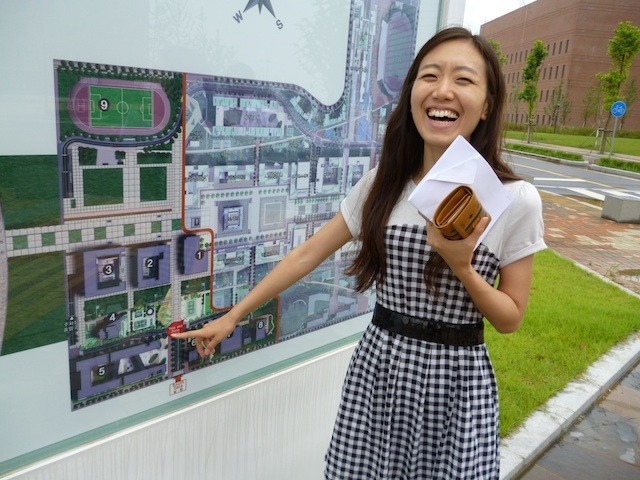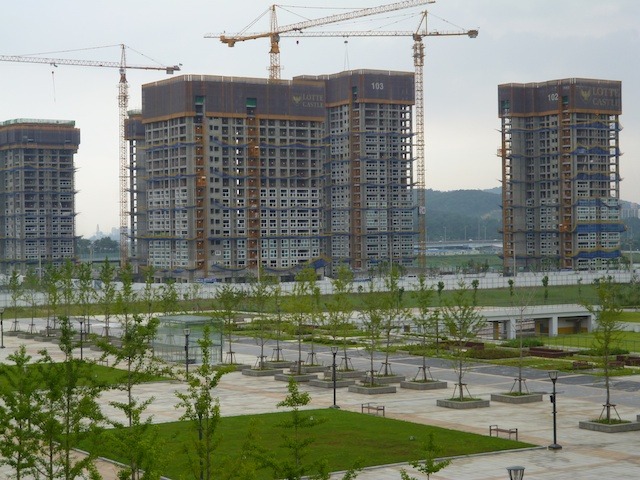
On the bridge from Songdo to Incheon Airport, apparently it's the fifth longest suspension bridge in the world
Last week my old Dartmouth classmate Michael Kim, now a professor of Korean history at Yonsei University, invited me to join him on a tour of the new Yonsei campus in Songdo. Songdo is an emerging "green city" built from scratch on a muddy stretch of reclaimed land near the Incheon airport. The foundations of the city seem to be constructed by driving concrete piles deep down into the mud and building upon them. Sound familiar? This is how Shanghai's Bund was built since the 19th century.

Laying the foundations for Songdo's Global Academic Complex
Songdo is an emerging "eco-city", one of many being built in an effort to minimize energy consumption and pollution by a combination of strategic urban design and information technology. I have been very interested in the concept of "green cities" and for a while I was following the story of Dongtan, an eco-city planned for Chongming Island at the mouth of the Yangzi River, not far from Shanghai. However, Dongtan's construction ground to a halt and since then I don't find any indication of that project continuing. From what I recall, word has it that the project was the initiative of Shanghai Mayor Cheng Liangyu, and after he fell from grace in 2006 and was imprisoned, the project fell through. But I'm sure there are others out there who could enlighten us as to what really happened with Dongtan.

Our guide shows us where we are on the map of Yonsei Songdo Global Academic Complex
Little chance of anything like that happening to Songdo. The project is in full swing and many buildings have already been completed and are operational. Aside from its claim to being a "green city", Songdo enjoys the advantage of being close to Incheon Airport, one of the main hubs in the Asian airspace. In the terminology of John Kasarda, who wrote the book on the subject, Songdo is an "aerotropolis." The city is designed to attract people who fly frequently. An aerial commuterville in other words.

The student dormitory at YSGAC
A few years ago (2006 to be exact) Yonsei was pulled into the project and agreed to build the Yonsei Songdo Global Academic Complex. Information about it in the form of a pdf file can be found on this site. Yonsei's Underwood International College was "invited" to join the project and now the entire freshman class of UIC is required to spend their year at Songdo. Since the project is still underway, the half-built campus has a bit of a ghost-town feel to it but I'm sure it will spruce up as time goes by and more buildings and parks are completed.
In addition, UIC is setting up an Asian Studies program at Songdo, which sounds very exciting. Students will be required to learn and use at least two out of the three major East Asian languages, namely Chinese, Korean, and Japanese. Apparently most of the students enrolled in the program will already be knowledgeable in at least one or two of these languages. The idea is educate students in East Asian humanities and cultures, making them cross-culturally fluent. I appreciate this because usually we are streamlined into focusing on one language and culture, certainly in undergrad years, and many students from my recollection who were forced to learn Japanese as grad students under Columbia's system went in kicking and screaming. I was happy to get a few years of Japanese language training in my early grad years, and now regret I didn't do the same with Korean.
Michael and some of the admin staff of UIC took me on a tour of the buildings on the Songdo campus, and while Michael lectured to a group of high school students about Yonsei's admissions process (extremely competitive from what I gather), we toured the student dormitory and the humanities building. I was very impressed by the quality of the buildings and the overall plan of the campus. The place definitely had that futuristic feel to it.

This building is currently being used for admin affairs but will house lecture halls and offices for faculty in the sciences (please correct me if I'm wrong--going by memory here)
There are a couple of good articles on Songdo for those interested. Here's one on Stanley Gale, the man hired to put the new city together, and how he brought Cisco in to wire the city and help design it. Seems that Cisco is getting into the business of building eco-cities, which should be highly rewarding in the future given China's rate of urbanization and the desperate need for environmental sustainability.

This building holds classrooms and offices for the Humanities programs
Here's another article on Songdo by the Independent, reported in 2009. While a certain healthy skepticism is in order about the viability of top-down urbanization projects, from what I witnessed on the ground, Songdo is already taking off in a big way and will be a very interesting project to monitor in the future. It is slated for completion by 2015. In addition to a "global campus" and a thriving business district with South Korea's tallest building, it will boast a NY-style "central park" (though how any other park could compare to the wondrous Central Park, my home away from home in NYC, is beyond imagining), an international school for children, as well as cultural venues such as museums.

Some apartment buildings under construction across from YSGAC
This brings us to a philosophical question of sorts: How can people live in a city without any history? While my own profession as an urban historian might bias me, I believe that one of the great aspects of living in a city is being able to delve into its historical layers and feel connected to them and grounded by them. The recent film by Woody Allen, Midnight in Paris, is an excellent exploration of the importance of history and urban mythology to the life of a city. In this film, the main character played by Owen Wilson, is whisked away every night at midnight from contemporary Paris into the "Crazy Years" of the 1920s. Every cliche you could imagine and every character you might think of from that era appear in the story. One of the great moments in the film is when a carriage arrives to whisk him and his potential 1920s lover from the 1920s into the 1890s, and one assumes that this process of nostalgic revelry could be continued ad infinitum into the Middle Ages and beyond.
Seoul definitely has these layers as well. Two weekends ago, Michael Kim took me on a brilliant driving tour of the city, during which he pointed out many of the older neighborhoods and buildings dating from the colonial Japanese occupation and back to the Choson dynasty. Living in a city such as Seoul, Shanghai, Beijing, Tokyo, Paris, London, New York or just about any metropolis with a grand history grounds us in history and gives us a sense of corporate and collective identity that goes beyond our belonging to company, family, or nation. It is a sense of collective experience and the feeling that one is contributing to an ongoing project of community building that stretches far back in time.
So what would it be like to live in a city that has no past? And whose identity is grounded solely in its construction as a metropolis of the future?